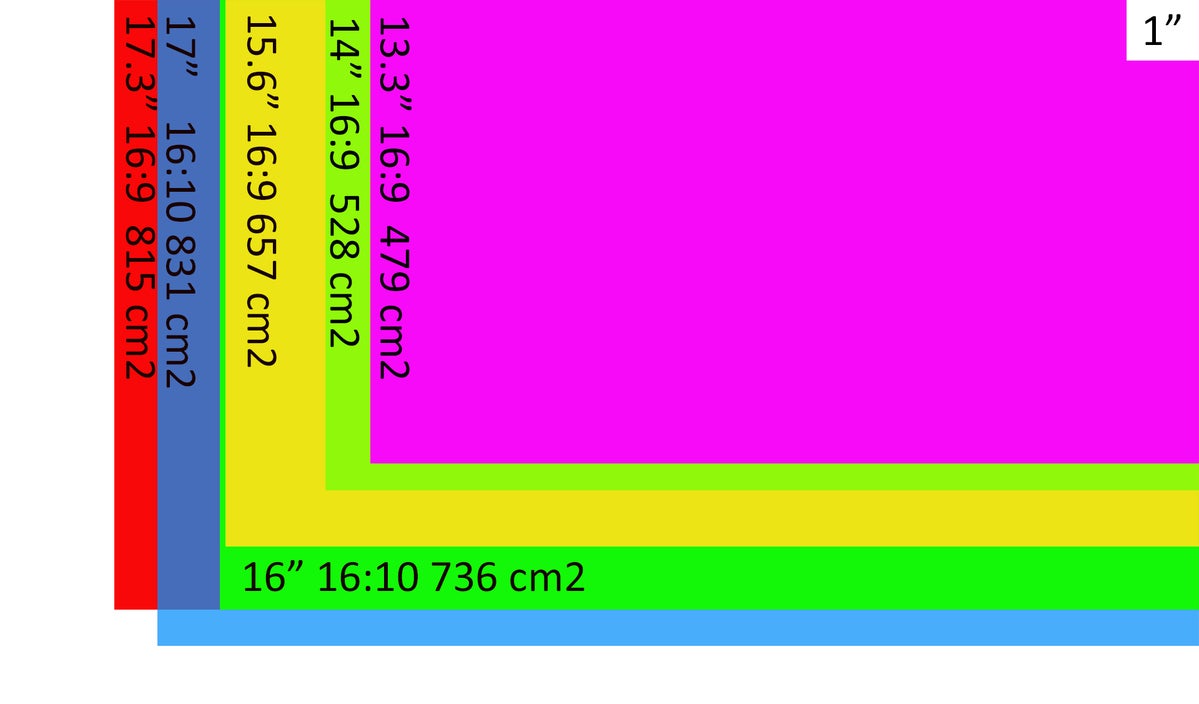Laptop With 1920x1080 Screen Resolution

Dell
In the world we live in, bigger is better. That, unfortunately, is how we got to a point where a 17.3-inch laptop screen isn't necessarily bigger than a 17-inch laptop screen.
And no, this isn't a fraction problem like the one that caused A&W to stop selling its third-pounder burger because people thought it was less than a quarter-pounder problem. Consumers legitimately expect a 17.3-inch laptop screen to be larger than a 17-inch one because 17.3 is bigger than 17. It's reasonable!
But the key problem here is the differing aspect ratio of laptops. The vast majority of 17.3-inch laptops feature screens with an aspect ratio—the proportion between the length and the height of the panel—of 16:9, similar to what you see in HDTVs.
The Dell XPS 17's panel is 16:10. It's taller. That difference means its 17-inch screen offers just under 2 percent more screen real estate than a 17.3-inch 16:9 panel. That's not a lot, but the fact that the average consumer will see 17-inches and think, "well, I want the larger screen, so I'll go for the 17.3-inch laptop" does a disservice to buyers.
Why do we even bother to measure laptop screens using a method dreamed up 70 years ago for TVs? Internet urban legend claims TV makers didn't want to explain the length and width of the screen, and using the diagonal measurement gave them a "bigger number to market."
Yes, that means we're still using a standard that was developed to fool consumers into thinking a 26-inch wood console TV was bigger. What's worse: The diagonal measurement doesn't even give them the bigger number to sell.
 IDG
IDG It's time to ditch the diagonal measurement that makes people think a 17.3-inch panel is larger than a 17-inch panel.
For this story, I physically measured the length and width of multiple laptops because most panels are typically a millimeter or so smaller than what the vertical measurement would have you believe. I apologize for pulling a NASA and mixing US Customary units and the metric system but the smaller units in the metric system make it easier to discuss.
Still, the most common panel in an ultra light laptop is a 13.3-inch 16:9 screen. On an HP Elite Dragonfly I measured, that works out to 29.2 cm wide x 16.4 cm tall, or 479 cm2 in total area. These laptops typically bump right up against 14-inch laptop using the same 16:9 aspect ratio such as the MSI Prestige 14 Evo, which I measured at 30.7cm wide and 17.2cm tall.
On the face of it, 0.7-inches is no big deal right? That's only about a 5 percent larger screen. But if you work out the actual surface area, the 14-inch laptop actually offers you 10.2 percent more area than the 13.3-inch laptop.
You'd probably say the same thing about laptops using the new crop of 16-inch panels that are popping up, such as the MSI Creator Z16. It's really only 0.4-inches more than the 15.6-inch panel in the Asus ROG Strix M16—just 2.5 percent—so again, not a big deal, right? In actual screen real estate though, it's closer to 12.1 percent larger, or 80 cm2 of total area. Heck, that's practically an Apple Touch Bar.
Unfortunately, like all whiners who can only point out what's wrong without suggesting any fixes, I can think of no easy way to cure the problem. We can't ask the average consumer to multiply the length by the width to derive the surface area of a screen. Saying one laptop has a 128 square inch screen vs. 126 square inches probably doesn't help either.
Maybe we should adopt some accepted arbitrary, but standardized measurement like we do for beds: King, Queen, Full and Twin. That leaves room for such things as California King (yes, it's a real thing) and the screen real estate is baked into expectation of size from a consumer.
Starbucks uses an arbitrary size for its coffee cups that could adopted. You have no idea how large that $6 Grande is, but you know it's good and bigger than a Venti. Oh, wait, maybe that's backwards—but you get the idea.
Consumers expect laptops with a larger stated screen size to be larger, but with 16:9, 16:10 and even 3:2 panels of all different dimensions and sizes, it's time to find something more accurate—even if it's something arbitrary that people can actually understand. So gimme that Dell XPS 17 with a Venti screen, please.
Note: When you purchase something after clicking links in our articles, we may earn a small commission. Read our affiliate link policy for more details.
- Related:
- Laptops
- HP
- Dell
One of founding fathers of hardcore tech reporting, Gordon has been covering PCs and components since 1998.
Laptop With 1920x1080 Screen Resolution
Source: https://www.pcworld.com/article/3630772/your-big-screen-laptop-may-be-smaller-than-you-think.html
Posted by: bivonasagen1999.blogspot.com

0 Response to "Laptop With 1920x1080 Screen Resolution"
Post a Comment